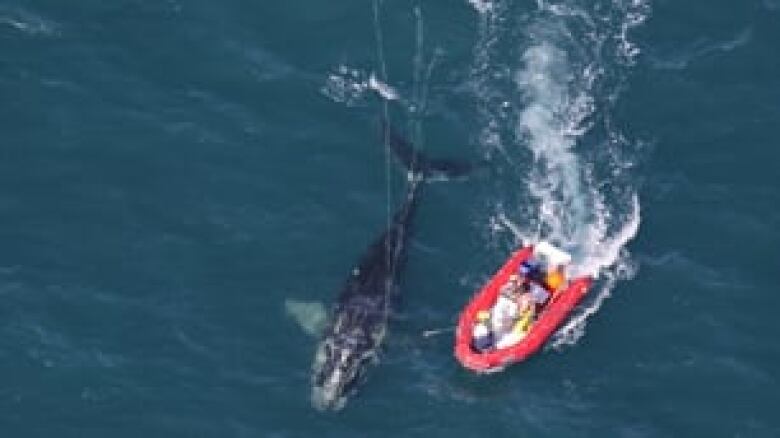Endangered right whale sedated, disentangled
U.S. wildlife scientists say they have successfully disentangled an endangered North Atlantic right whale using at-sea chemical sedation, marking the second time a "free-swimming" whale has been sedated to remove ropes from its body.
The young female, born during the 2008-09 calving season and estimated at nearly 10 metres, was swimming off the coast of Florida on Christmas Day when it was spotted by an aerial survey team. It was dragging fishing rope and wire mesh.

Five days later, a team from the Georgia Department of Natural Resources and Florida Fish and Wildlife Conservation Commission was able to remove 46 metres of rope. But an additional 15 metres remained wrapped through its mouth and around its flippers.
So scientists with the National Oceanic and Atmospheric Administration, along with state and non-profit group scientists, tracked the animal via satellite tag to see if it could shed the remaining rope on its own.
When the whale still hadn't disentangled itself by Jan. 15, the scientists moved in. Working off the coast of Cape Canaveral, they injected it with asedative so they could safely move their boat close enough to cut the animal free. Before leaving the whale's side, they also injected it with antibiotics to fight possible infection in its wounds.
"Our recent progress with chemical sedation is important because it's less stressful for the animal, and minimizes the amount of time spent working on these animals while maximizing the effectiveness of disentanglement operations," Jamison Smith, of NOAA's Fisheries Service, said in a release. "This disentanglement was especially complex, but proved successful due to the detailed planning and collective expertise of the many response partners involved."
NOAA continues to track the animal's progress.
Fishing gear removed from the whale was similar to what is used in the trap or pot fisheries for fish, crabs and lobsters along the mid-Atlantic, northeast U.S., and Canadian coasts.
With an estimated 300 to 400 North Atlantic right whales left, the creatures are among the most endangered whales in the world.
The first time a whale was successfully sedated and disentangled was in March 2009 off the coast of Florida, say NOAA officials.












_(720p).jpg)


 OFFICIAL HD MUSIC VIDEO.jpg)
.jpg)



























































































